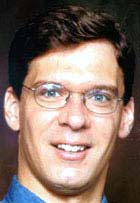

Marvin Gaye wailed in the ’60s hit “Heard it through the Grapevine” that we’re supposed to believe just half of what we see.
Biomedical engineer Daniel Moran, Ph.D., and University of Pittsburgh researchers, have identified areas of the brain where reality and illusion are processed. For instance, the first time you don a new pair of bifocals, there is a difference in what you percieve visually and what your hand does when you reach for something. With time, though, the brain adjusts so that vision and action become one. The ventral premotor complex plays a major role in that process.
But a new collaborative study involving a biomedical engineer at Washington University in St. Louis and neurobiologists at the University of Pittsburgh shows that sometimes you can’t believe anything that you see. More importantly, the researchers have identified areas of the brain where what we’re actually doing (reality) and what we think we’re doing (illusion, or perception) are processed.
Daniel Moran, Ph.D., Washington University assistant professor of biomedical engineering and neurobiology, and University of Pittsburgh colleagues Andrew B. Schwartz, Ph.D., and G. Anthony Reina, M.D., focused on studying perception and playing visual tricks on macaque monkeys and some human subjects. They created a virtual reality video game to trick the monkeys into thinking that they were tracing ellipses with their hands, though they actually were moving their hands in a circle.
They monitored nerve cells in the monkeys enabling them to see what areas of the brain represented the circle and which areas represented the ellipse. They found that the primary motor cortex represented the actual movement while the signals from cells in a neighboring area, called the ventral premotor cortex, were generating elliptical shapes.
Monkey thought it saw, then monkey didn’t do.
The research shows how the mind creates its sense of order in the world and then adjusts on the fly to eliminate distortions.
For instance, the first time you don a new pair of bifocals, there is a difference in what you perceive visually and what your hand does when you go to reach for something. With time, though, the brain adjusts so that vision and action become one. The ventral premotor complex plays a major role in that process.
Knowing how the brain works to distinguish between action and perception will enhance efforts to build biomedical devices that can control artificial limbs, some day enabling the disabled to move a prosthetic arm or leg by thinking about it.
Results were published in the Jan. 16, 2004 issue of Science.
“Previous studies have explored when things are perceived during an illusion, but this is the first study to show what is being perceived instead of when it is happening,” said Moran. “People didn’t know how it was encoded. And we also find that the brain areas involved are right next to each other.”
The researchers next plan to record and determine how the transformation takes place by recording in both areas simultaneously.
“We might let the monkeys know that they are making a mistake and see how they rectify that. What I think is most interesting involves motor learning. We want to see how the brain learns and adapts its encoding parameters to account for visual illusions.”














